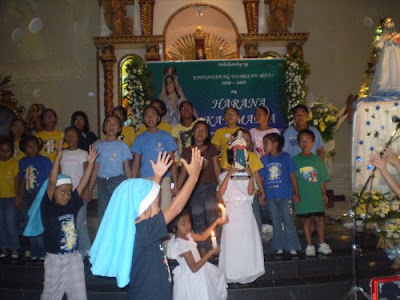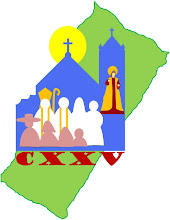As linked in the Roman Catholic Archdiocese of Manila's website, we also encourage faithful and devout Catholics to support the stand of the Holy Church as say No to Reproductive Health Bill (HB5043) by signing on this
petition.
Here is an article in the said website. It is the CBCP President Angel Lagdameo's Homily during the Mass in 40th year on Humanae Vitae, Pope Paul Vi's encyclical on human life, specifically, the regulation of birth.
Celebration of Human LifeHomily of Archbishop Angel N. Lagdameo
July 25, 2008
Nagpapasalamat tayo sa Diyos at ipinagdiriwang natin ngayon ang ika-apatnapung taon ng Sulat Ensiklika ni Papa Paulo VI tungkol sa “Human Life.”
Bakit natin ito ipinagdiriwang? Sapagkat sa kanila ng pag-atake sa buhay ng tao, lalo na sa sinapupunan ng ina (abortion), at laban sa ekspektasyon na luluwagan ng Simbahan ang tradisyonal na mga turo tungkol sa moralidad ng mag-asawa at moralidad ng pamilya, lalo pang pinagtibay ng Simbahan ang traditional na turo tungkol sa birth control at responsableng pagmamagulang.
Pinaaalala sa atin ngayon ang turo sa Sulat “Humanae Vitae” na ang buhay ng tao mula sa sinapupunan hanggang libingan, ay bigay, handog, alay ng Diyos. Walang sinumang may ari sa buhay ng tao, hindi ang tao mismo, hindi ang mga mambabatas, ni ang pamahalaan, kungdi ang Diyos lamang. – Ang bawat sanggol na isinisilang ay handog ng Diyos sa kanyang mga magulang at buong pamilya. – Ang pro-active na saloobin tungkol sa mga isinisilang sa lipunan: sila ay hindi basta pabigat lamang sa bulsa, kundi sila ay magiging puersa ng bayan para sa hinaharap na kaunlaran. – Samakatuwid ang karangalan, at ang kahalagahan ng buhay pantao ay dapat respetuhin at ipagsanggalang sa lahat ng paraan.
May mga kapatid tayo na nag-uumpisang mag-panic dahil sa mga babala ng mga ecologists at futurologists tungkol sa mabilis na pagdami ng tao: ang pagdami daw po ng populasyon ay baka hindi makayanan ng ekonomiya, sa pagdaming ito dadami ang mga pobre at mga squatters, sa pagdaming ito ang kalidad ng buhay ay mababawasan.
Kaya natin malampasan at malutas ang mga babalang ito kaugnay ng pagdami ng tao, kung ang lahat, lalo na ang mga dalubhasa, ay magkakatulungan at magkakaisa. Huwag lang po natin pakikialaman ang buhay na bigay ng Diyos. Tutulungan tayo ng Diyos ng buhay!
Pope Paul VI in Humanae Vitae and Pope John Paul II (March 25, 1995) have re-stated that the mission of the church is to celebrate human life, as the Gospel of life, that human life has a deeper meaning and beauty outside of what we see, that every human being must be respected, honored and loved, that we must praise and thank God for the gift of life.
Kasama sa mga lantaran at tagong pag-atake sa buhay ng tao sa sinapupunan at pag-atake sa moralidad ng mag-asawa at pamilya ang isang maling Konsepto ng Kalayaan (concept of freedom) na humahantong sa relativismo: ibig sabihin walang matibay na kabutihan at katotohanan na pumipigil sa tao. Ang lahat ay relative – puedeng mapag-usapan at matawaran . . . lakip na dito ang karapatan sa buhay . . . depende sa negotiation o bargaining ng mga tao . . . Nasaan ang Diyos sa tawarang ito?
Kailangang ibalik natin at pagtibayin sa lipunan ang sense of God, ang presensya at ang papel ng Diyos. Kung mawala ang sense of God, mawawala na rin ang sense of man’s dignity and life. Ang bunga nito ay materialismo, na nagbubunga ng individualismo, utilitarianismo … at hedonism (EV 21-22).
Hindi ipinagbabawal ng simbahan ang pag-family planning. Pahintulot po yan. Pero sa ngayon sa turo ng mga Ensiklika “Humanae Vitae” at “Evangelium Vitae” pinahinintulutan ng ating moralidad ay ang “natural family planning” bilang paraan sa responsableng pagmamagulang. Sa ganitong layunin ang sinusunod natin sa pagplano ng panganganak ay hindi artipisyal na metodo, gadget or instrumento na ginawa ng tao, kungdi ang batas na inilagay ng Diyos sa mismong naturaleza ng katawan ng ina.
Pinahihintulutan ng Simbahan ang “population management” (ang pagpapadami o pagbabawas ng panganganak), kung ang paraan nito ay hindi lumalabag sa kautusan o kalooban ng Diyos ng buhay at kung ang paraan nito ay may respeto sa consciensya, karapatan at kalayaan ng mag-asawa. [Ang batas ay para sa tao at hindi ang tao para sa batas.] Dapat igalang ang konsiyensiya at desisyon ng mag-asawa sa pagdedesiyon kung ilan ang magiging anak sang-ayon sa kalooban ng Diyos.
Ang “artificial birth control,” na ginagamitan ng mga contraceptives, gadgets at abortifacients, ay labag sa institusyon, at integridad ng pag-aasawa.
Our Philippine Constitution, in Article II, Section 12, specifies the function of the state: “The State recognizes the sanctity of family life and shall protect and strengthen the family as a basic autonomous social institution. It shall equally protect the life of the mother and the life of the unborn from conception. The natural and primary right and duty of parents in the rearing of the youth for civic efficiency and the development of moral character shall receive the support of Government.”
Ang pamilya ay ang pundasyon ng lipunan. (As the family goes so goes the nation.) Kung ang Pilipinong pamilya ay masira o magiba, gayundin masisira at magigiba ang Pilipinong lipunan. Samakatuwid dapat pagkaabalahan hindi lamang ng Simbahan, kundi ng sangkalipunan at pamahalaan ang pangsasanggalang at pagpapatibay ng Pilipinong pamilya.
[The subtle attacks on family and conjugal morality through legislations that promote artificial methods of birth control, are couched in attractive but deceptive (double meaning) terminologies, like reproductive health care, population management, anti-discrimination of women and children, reproductive rights, patients’ rights.]
Na-predict, nahulaan at na-warningan na tayo ni Papa Paulo VI at ito’y pinatotohanan (confirmed) ni Papa Juan Pablo II na ang artificial methods of birth control ay magbubunga ng pagbaba ng moralidad ng mag-asawa, magbubunga ng pagkawala ng katapatan ng mag-asawa sa isa’t isa, magbubunga ng pagbaba o pagkawala ng respeto sa kababaihan . . . Isama na natin dito ang mga sakit sikological at pisikal na manggagaling dito sang-ayon sa mga dalubahsa.
Sinasabi po ng ilan na lumalawak ang kahirapan sa daigdig, padami ng padami ang mga pobre, na dapat daw pagbutihan pa ang kalidad ng buhay. Upang maganap ito ang mga pamilya ay dapat maging responsible at hindi hihigit sa dalawang anak lamang sa bawat mag-asawa.
Si Dr. Joseph Chamie ng United Nations Population Division ay naglahad noon pang 1998 na ang problema na ating hinaharap ay hindi “population explosion” (pagdami ng tao) kundi ang problema na ating hinaharap ay “population implosion,” (pag-unti ng tao). Sa mahigit na limampu’t isang bansa ang bilang ng mga ipinanganganak ay pababa ng pababa kung kaya’t magiging imposible na maulian ang bilang ng mga namamatay na bilang ng mga isinisilang.
Ang mga bansa na nagtagumpay sa polisiya na “dalawang anak lamang” ay nababahala na ngayon sa patuloy na pagbaba o pag-unti ng kanilang populasyon kung kaya’t napipilitan na sila ngayong tumanggap ng mga taga-ibang bansa (mga Asiatiko) para magtrabaho sa kanilang mga industriya at mag-alaga sa kanilang mga senior citizens.
Si Kofi Annan, ang dating sekretario general ng United Nations ay nagsabi nuong 2004 na ang daigdig natin ay patanda ng patanda (Europa at mga America). Sa darating na 2030 ang world population na nasa edad 45 patanda ay magiging mas madami kaysa mga kabataan na nasa edad 44 pababa. Paunti ng paunti ang mga kabataan at mga manggagawa na susuporta sa malaking populasyon na mga matatandang senior citizens. Ang resulta sa ibang bansa ay euthanasia.
At dito sa ating bansa? Sinasabi po ng ilan (mambabatas) na ang population growth rate natin ay 2.36%. Ang USAID at ang UN ay nagsasabi naman na mas mababa doon ang ratio ng ating pagdami. Noong 2004 Disiembre nag project ang National Statistics Office na ang ating population growth rate at magiging 1.99%,
Hindi natin nahahalata ang pag-unti ng ating population kung tututukan natin ay mga thickly populated na lungsod na maraming mga squatters at patung-patong na bahay, kahit sa ilalim ng mga tulay. Siyamnapung milyon na ang ating populasyon. At 10 milyon o mahigit pa sa bilang na ito ay nasa ibang mga bansa. Dinadala dito sa Pilipinas ang development ng ibang bansa; maganda ang mga bahay, at nakakapag-aral ang mga anak ng mga OFW.
Kung natatakot sa mabilis na pagdami ng tao … 90 milyon o mahigit pa … kontrolin ang pagdami pero sa moral at tamang paraan sang-ayon sa kalikasang inilagay ng Diyos. Iyan ang prinsipyong pinagtibay ng Humanae Vitae at Evangelium Vitae.
Sa pagsunod sa batas ng Diyos, sampu ng pagtitiwala sa tulong at awa ng Diyos, malulutas nating sama-sama ang problema ng populasyon at ekonomiya, ang problema ng karukhaan at kahirapan ng mahigit sa 80% ng mga mamamayan.
Hindi po yan malulutas ng rallying ito. Nandito tayo para ipagdasal ang bansa, liwanagan ng Diyos tayong lahat . . . para makatulong, makatulung-tulungan sa pag-unawa at paglutas sa mga problema natin.
.Kung ang lahat ng salapi na nililikum ng pamahalaan sa mga taong-bayan ay hindi napupunta sa kagarukan o katiwalian – graft and corruption at hindi nagagastos sa maling pagkakagastos – tiyak na malaking mababawas sa bilang ng mga pobre, magkakaroon tayo ng populasyon at ng progreso, magkakaroon tayo ng populasyon na siyang magiging puwersa at alituntunin ng kaunlaran.
Ang isyu po ngayon ay hindi lamang “pro-God” at “pro-life.” Tanungin po ninyo ako: Bakit? Bakit? Sapagkat kalakip ng issue ng “pro-life” ay “pro-poor,” Kung tayong lahat ay “pro-life” . . . dapat maging “pro-poor.” Bakit? Sapagkat dadami daw po ang mga pobre . . . hindi lang dadami . . . madami na! Pero yan ay hindi problema ng Diyos . . . . problema yan natin at ang mga mayayaman at ng pamahalaan!
Hindi ba sinabi natin kanina na tayo ay “pro-God?” Pwes, kung pro-God tayo . . . dapat ay pro-poor din, ibig sabihin lalabanan natin ang kahirapan! Ibig sabihin, susugpuin natin ang mga dahilan ng kahirapan . . . at lalabanan natin ang mga nagpapahirap sa kapwa.
Kung ikaw ay hindi “pro-poor,” hindi ka rin pro-God. Sapagkat ang Diyos ay nabibilang . . . kasama ng mga mahihirap . . . . mas pinili niya na maging mahirap sapagkat mas marami sila. Pro-God dapat pro-poor. 1 Jo. 3/17 “Kung ang isang tao ay maraming ari-arian (salapi) at nakita niya ang kanyang kapatid na nangangailangan, subalit hindi siya naawa, nahabag, tumulong, paano ang pag-ibig ng Diyos ay mapapasa kanya?
Hindi dapat mangyari na controlahin ang pagdami ng dalawang bahagi ng populasyon para lamang makapagpatuloy magpasasa sa kanilang kayamanan ang menos sa isang bahagi ng mga mayayaman. Iyon ay mathematics of selfishness. Kung mangyayari ito, ang lupa at ang pribadong pagmamay-ari ay magiging potential na larangan ng digmaan ng mayayaman at mahihirap.
Kailangan natin ang “change of attitude.” Hindi pwedeng magpatuloy ang attitude na “What is mine is mine absolutely and I can do with it as I wish.,” o ang saloobin na “my money entitles me to consume or control on my own terms as much as my money will buy.”













.JPG)











































